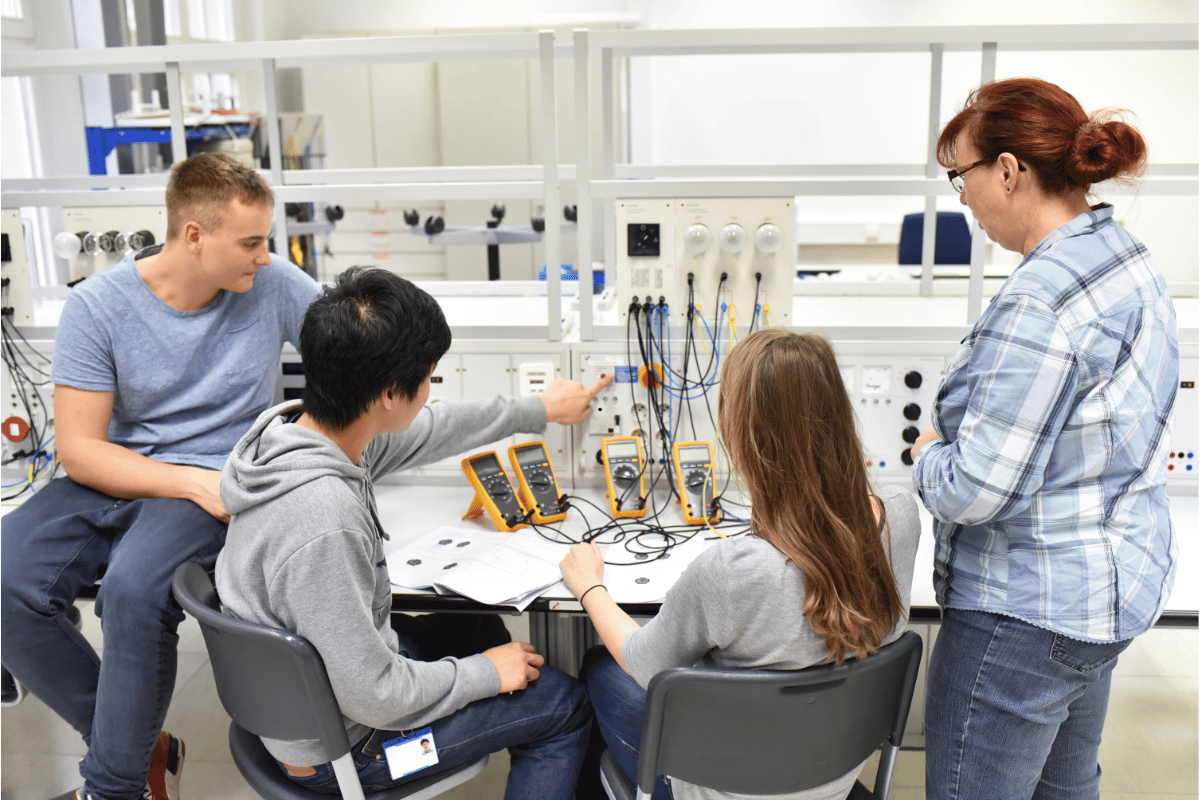Vocational Training Basics
Vocational training, also known as career training, is all about getting your hands dirty and learning the ropes of a specific job. It’s like the “Learning by Doing” school of thought, where you spend most of your time practicing the skills you’ll actually use on the job. This practical approach makes vocational training stand out from other types of education.
Hands-On Learning
In vocational training, you don’t just sit around reading textbooks. You dive right into real-world tasks and scenarios that are relevant to your chosen field. This hands-on experience helps you pick up and polish the skills you’ll need to succeed at work. By getting involved in practical exercises, simulations, and projects, you can connect the dots between what you learn and how it’s used in the real world.
One cool thing about this approach is that you get to work with classmates from all sorts of backgrounds. This not only helps you learn better communication skills but also preps you for working in a globalized world. Plus, the intense nature of these programs means you build strong relationships with your peers and instructors, creating a supportive learning environment (EHL Insights).
Why Vocational Education Rocks
Vocational education has some pretty sweet perks for anyone looking to jumpstart their career. Here are a few highlights:
- Real-World Experience: Vocational training gives you hands-on experience in your chosen field. Through internships, apprenticeships, and practical coursework, you get a taste of the real world, making you job-ready as soon as you graduate. This practical experience can give you a leg up when you’re job hunting.
- Career Opportunities: These programs focus on the skills needed in various industries like healthcare, hospitality, and construction. By offering specialized training, vocational education opens up a ton of career opportunities. Graduates often find it easier to land jobs because of their specific skill set and industry know-how.
- Quick Entry into the Workforce: With vocational training, you can start working sooner than if you took a traditional academic path. Since you graduate with practical experience and targeted training, you can jump into entry-level positions with minimal additional training, speeding up your career progression.
- Industry Connections: Vocational programs often have ties with industry pros and companies. This means you can network with potential employers, stay updated on industry trends, and access job placement services. These connections can be super helpful when you’re looking for a job.
In a nutshell, vocational training offers a practical, hands-on approach to education. It equips you with the skills you need to succeed in your chosen career and comes with a bunch of benefits like real-world experience, career opportunities, quick entry into the workforce, and strong industry connections.
Vocational Training Programs
Vocational training programs give folks a chance to pick up practical skills and know-how in various industries. These programs are all about getting students ready for real-world jobs in their chosen fields. You can break them down into three types: short-term, medium-term, and long-term programs.
Short-Term Programs
Short-term vocational training programs are like crash courses. They get you up to speed with essential skills in no time. Perfect for those who want to quickly snag entry-level jobs or boost their current skills. These programs can last from a few weeks to several months.
Take construction, for example. Short-term programs here might cover the basics like safety, electrical wiring, plumbing, and carpentry. They’re flexible and hands-on, prepping you for entry-level gigs in the industry (PTTI).
Medium-Term Programs
Medium-term vocational training programs go a bit deeper. They usually last from a few months to a year and cover more advanced stuff. These programs are great for those who want to specialize a bit more in their field.
In construction, medium-term programs might dive into trades like welding, HVAC systems, and project management. They also touch on hot topics like sustainable building practices. These programs set you up for specialized trades or mid-level roles.
Long-Term Programs
Long-term vocational training programs are the deep dive. They’re for folks who want to become experts in their field. These programs can last from a year to two or more.
In construction, long-term programs cover advanced techniques, project management, and other specialized areas. They prep you for top-tier positions and might even give you the skills to start your own business. Internships and apprenticeships are often part of the deal, giving you real-world experience and networking opportunities.
Vocational training programs come in all shapes and sizes, catering to different needs and goals. Whether you’re looking to jump into the workforce quickly or aim for higher positions, there’s a program out there for you. Think about your career goals and the expertise you need when picking the right vocational training program.
Vocational Training Considerations
Picking the right vocational training course can feel like a big decision, but it doesn’t have to be overwhelming. Whether you’re eyeing vocational training for trades, vocational training for healthcare, or vocational training for entrepreneurship, here are some key things to keep in mind to make sure you choose the best program for you.
Choosing the Right Program
First things first, you need to find a program that matches your career goals. Spend some time digging into the different options out there, like vocational schools and vocational training programs. Think about the skills and knowledge you want to pick up and make sure the program covers those bases.
Also, check out the reputation of the training provider. Look for reviews, testimonials, and success stories from past students. This will give you a good idea of the program’s quality and whether it’s worth your time and money.
Accreditation and Faculty Expertise
Accreditation is a big deal. It means the program has met certain quality standards set by accrediting bodies, so you know you’re getting a solid education. Look for programs accredited by reputable organizations in your field of interest.
The expertise of the faculty is another important factor. Instructors with real-world experience can offer valuable insights and practical knowledge. Do a bit of homework on the qualifications and backgrounds of the faculty members to make sure they know their stuff.
Financial Considerations
Money matters, right? Take a close look at the overall cost of the program, including tuition and any extra fees. Compare the costs of different programs and think about the value you’ll get in terms of the skills and knowledge you’ll gain.
Vocational education programs are usually cheaper than other types of learning institutions, making them a more budget-friendly option for many people (EHL Insights). Also, check out financial aid options, scholarships, or grants that might be available to help cover the costs.
Before you make your final decision, think about the return on investment (ROI) of the program. Look into the job market and potential earning opportunities in your chosen field after completing the training. This will help you figure out if the financial investment in the program is likely to pay off in the long run.
By keeping these factors in mind – choosing the right program, ensuring accreditation and faculty expertise, and evaluating financial considerations – you can make a smart decision and pick a vocational training course that will set you up for a successful career.
Vocational Training Around the World
Vocational training programs are available globally, helping folks gain specialized skills for various industries. Let’s take a closer look at vocational training in Germany and Australia, and also touch on how long these programs usually last.
Vocational Training in Germany
Germany’s vocational training system is top-notch, thanks to its dual model. This setup mixes classroom learning with hands-on training at companies. You get to learn and earn at the same time, setting you up for a solid career in fields like engineering, healthcare, and hospitality.
Germany offers nearly 350 different vocational training options (Make it in Germany). Companies are legally required to pay apprentices and provide necessary gear like tools or safety equipment. The tasks given to apprentices must help them learn their trade.
Laws in Germany protect apprentices’ rights, making sure they attend classes and put in the effort to learn. If non-EU citizens can’t finish their training due to illness or other reasons, they might get an extra six months to find another training spot, according to Section 16a (4) of the Residence Act (AufenthG) (Make it in Germany).
Vocational Courses in Australia
Australia offers a wide range of vocational courses to meet industry needs. These courses give you practical skills to excel in your chosen field. Some popular options include:
- SIS30321 Certificate III in Fitness: With more people looking for fitness instructors and personal trainers, this course preps you to meet the health and wellness needs of the community.
- TAE40122 Certificate IV Training and Assessment: If you want to become a trainer or assessor, this course is a must. It teaches you how to deliver effective training and assess learners’ skills.
- MEM30219 Certificate III in Engineering – Mechanical Trade: With a growing need for mechanical tradespeople, this course equips you with the skills needed in manufacturing and construction (Compliant Learning Resources).
- SIS40221 Certificate IV in Fitness: Aimed at those wanting to start their own fitness business or take on leadership roles, this course covers advanced topics in anatomy, physiology, and exercise prescription.
- CPC20120 Certificate II in Construction: This course gives you the skills to support construction projects, meeting the demand in civil engineering and residential construction.
These are just a few examples. Australia offers a variety of programs to suit different industries and career paths.
Vocational Training Program Duration
The length of vocational training programs varies by course and country. In Germany, these programs usually last between two and three and a half years, depending on the job’s complexity and required qualifications (Make it in Germany).
In Australia, vocational courses can last from a few months to several years. Short-term courses might be a few weeks or months, while medium-term programs can last six months to a year. Long-term programs, like apprenticeships, can take several years, giving you plenty of practical experience while you study (Compliant Learning Resources).
When choosing a vocational training program, consider how long it takes and how it fits with your career goals and personal situation.
Vocational training in Germany and Australia offers practical skills that are in high demand. Whether you go for Germany’s dual system or Australia’s diverse courses, these programs provide a strong foundation for a successful career in many industries.


